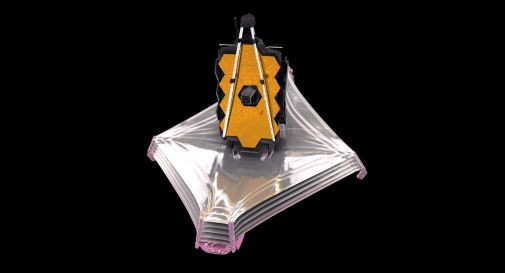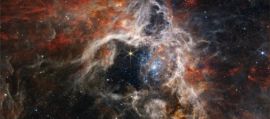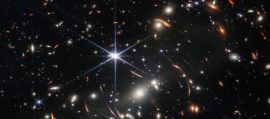Il telescopio spaziale Webb completa un altro importante traguardo
Il parasole di Webb è ora completamente dispiegato. Una delle parti più critiche e rischiose del viaggio di JWST, spiegando l'importantissimo parasole, è stata completata con successo.
| Richard Brewer |

Immagine del parasole completamente dispiegato prima di aprire gli specchi (Credito NASA)
USA - 4 gennaio 2022, questo nuovo anno inizia con il successo dello spiegamento dello schermo solare del James Webb Space Telescope (JWST), cruciale per portare a compimento una nuova era dell'esplorazione spaziale. Alle 16:59 GMT (11:59 EST), un enorme sospiro di sollievo poiché è stato completato lo spiegamento più complesso mai tentato dalla NASA. Con lo scudo protettivo ora completamente esteso e i cinque strati separati e tirati nella loro forma tesa finale, può iniziare la fase successiva del processo, dispiegando gli specchi primari e secondari dorati.
Lanciato dallo spazioporto dell'ESA a Kourou, nella Guyana francese, il giorno di Natale, 25 dicembre 2021, l'osservatorio spaziale ha iniziato il suo viaggio ripiegato in stile origami a bordo del razzo Ariana 5. Concludendo 25 anni di sviluppo, il telescopio spaziale più grande e complesso del mondo si sta lentamente aprendo come un fiore d'argento e d'oro che si prepara a scrutare in profondità nel cosmo.
Dieci giorni dopo il lancio, il telescopio è ora al 64% della strada verso la sua futura casa, il punto di Lagrange gravitazionalmente neutro L2, a 1,5 milioni di chilometri dalla Terra. Dopo aver completato finora 920.000 km del suo viaggio, sta navigando nello spazio a 0,5 km/sec e dovrebbe arrivare a L2 entro la fine di questo mese. Ora ha completato il rischioso compito di aprire il suo parasole per proteggere i suoi specchi e gli strumenti dal calore del sole.
Mercoledì 29 dicembre, il gruppo della torre è stato sollevato di circa 1,2 m (4 piedi) fornendo spazio affinché le membrane del parasole si dispiegassero completamente. Giovedì le coperture che proteggevano i sottili strati del parasole durante il lancio sono state rilasciate e arrotolate in posizione di attesa. Questo ha esposto le membrane allo spazio per la prima volta.
Il parasole prende forma: alla vigilia di Capodanno, venerdì 31 dicembre, entrambi i bracci centrali del parasole sono stati estesi con successo e l'osservatorio ha superato un'altra pietra miliare del dispiegamento critico. La NASA riferisce che il parasole ora assomiglia alla sua forma completa a forma di aquilone nello spazio. Tutti i 107 dispositivi di rilascio della membrana utilizzati per mantenere il parasole al sicuro e piegato prima dell'apertura - ognuno di essi - dovevano funzionare affinché il parasole si aprisse, e tutti sono stati rilasciati con successo.
I bracci intermedi si sono lentamente spinti fuori orizzontalmente dal veicolo spaziale, ciascuno azionato da un motore mentre tiravano con sé le membrane piegate dello schermo solare, estendendolo per tutta la sua larghezza di 14,33 m (47 piedi) attraverso l'osservatorio. I due bracci intermedi sono stati bloccati nella loro posizione finale tenendo le membrane in posizione.
Dopo essersi soffermati ad analizzare il comportamento dei motori del telescopio e della fonte di alimentazione nel loro nuovo ambiente spaziale, hanno riallineato la navicella spaziale per far uscire i motori dalla linea diretta del sole per mantenerli freschi. Questo è stato seguito dal proseguimento delle fasi finali dell'installazione del parasole lunedì 3 gennaio. I cinque strati sono stati tensionati individualmente, allungandoli nella loro forma finale e tesa e creando uno spazio tra ciascuno di essi per consentire al calore di irradiarsi e rendere ogni strato successivo più fresco di quello sottostante.
Martedì 4 gennaio 2022, alle 16:59 GMT, il parasole era completamente teso, segnando il completamento dell'apertura del parasole. Il tensionamento degli strati ha richiesto due giorni per essere completato con i comandi per attivare diversi motori per tirare un totale di 90 cavi attraverso circa 400 pulegge . Sono iniziati lunedì con lo strato uno, lo strato inferiore, cioè il più grande e quello più vicino al Sole che raggiungerà la temperatura più alta. Martedì, gli strati da due a cinque sono stati tesi con successo uno per uno.
Inizia il raffreddamento: gli strumenti sono ora in ombra e non vedranno mai più la luce solare diretta. Lo schermo solare consentirà al telescopio di raffreddarsi a una temperatura inferiore a 50 Kelvin (-370º F o -223º C) irradiando passivamente il suo calore nello spazio. I cinque strati riducono l'esposizione al sole da oltre 200 kilowatt di energia solare a una frazione di watt.
Lo spiegamento e il bloccaggio al posto degli specchi primario e secondario è il prossimo grande evento e inizierà presto. Dopo essere arrivati nel luogo di osservazione alla fine di gennaio e aver completato il raffreddamento alla sua temperatura operativa, gli strumenti verranno gradualmente accesi, calibrati e testati, quindi i singoli segmenti dello specchio saranno accuratamente allineati e entro giugno o luglio potremmo ricevere le prime immagini.
**************** IN ENGLISH *****************
Webb Space Telescope Completes another Major Milestone
The Webb’s sunshield is now fully deployed. One of the most critical and riskiest parts of JWST's journey, unfolding the all-important sunshield, has been successfully completed.
USA - 4 January 2022, this new year begins with the successful unfolding of the James Webb Space Telescope (JWST) sunshield that is crucial to bringing a new era of space exploration closer to fruition. At 16:59 GMT (11:59 a.m. EST), a huge sigh of relief as the most complex deployment ever attempted by NASA was completed. With the protective shield now fully extended and the five layers separated and pulled into their final taut shape the next stage of the process, unfolding the golden primary and secondary mirrors, can start.
Launched from the ESA spaceport in Kourou, French Guiana on Christmas Day, 25 December 2021, the space observatory began its journey folded up origami style aboard the Ariana 5 rocket. Culminating 25 years of development, the worlds largest, most complex space telescope is slowly unfolding like a silver and gold flower preparing to peer deep into the cosmos.
Ten days after launch the telescope is now 64% of the way to its future home, the gravitationally neutral Lagrange point L2, 1.5 million kilometers from Earth. Having completed 920,000 km of its journey so far, it is cruising through space at 0.5 km/ sec and is due to arrive at L2 by the end of this month. It has now completed the risky task of unfolding its sunshield to protect its mirrors and instruments from the heat of the sun.
On Wednesday, 29 December, the tower assembly was raised up about 1.2 m (4 ft ) providing room for the sunshield membranes to fully unfold. On Thursday the covers that protected the thin layers of the sunshield during launch were released and rolled up into a holding position. This exposed the membranes to space for the first time.
The Sunshield Takes Shape: On New Years Eve, Friday, Dec 31, both of the sunshield mid-booms were successfully extended and the observatory passed another critical deployment milestone. NASA reports the sunshield now resembles its full kite shaped form in space. All 107 membrane release devices used to keep the sunshield safe and folded prior to deployment — every single one — had to work in order for the sunshield to deploy, and they all successfully released.
The mid-booms slowly pushed out horizontally from the spacecraft, each driven by a motor as they pulled the folded membranes of the sunshield with them, extending it to its full 14.33 m (47 ft) width across the observatory. The two mid-booms were locked in their final position holding the membranes in place.
After pausing to analyze the behavior of the telescope motors and power source in their new space environment, they realigned the spacecraft to get the motors out of the direct line of the sun to help keep them cool. This was followed by continuing the final stages of sunshield deployment on Monday, 3 January. The five layers were individually tensioned, stretching them into their final, taut shape and creating a space between each of them to allow heat to radiate out and make each successive layer cooler than the one below.
Tuesday, 4 January 2022, at 16:59 GMT the Sunshield was fully tensioned, marking completion of the sunshield deployment.Tensioning the layers took two days to complete with commands to activate several motors to pull in a total of 90 cables through about 400 pulleys. They began on Monday with layer one, the bottom layer, that is the largest and the one closest to the Sun that will reach the highest temperature. By Tuesday, layers two through five were successfully pulled taut one by one.
Cooling begins: The instruments are now shaded and will never again see direct sunlight. The sunshield will allow the telescope to cool down to a temperature below 50 Kelvin (-370º F or -223º C) by passively radiating its heat into space. The five layers reduce exposure from the Sun from over 200 kilowatts of solar energy to a fraction of a watt.
The unfolding and locking in place of the primary and secondary mirrors is the next major event and will begin soon. After arriving at its observing location at the end of January and completing the cool down to its operational temperature, the instruments will be gradually switched on, calibrated and tested, then the individual mirror segments will be carefully aligned and by June or July we may receive the first images.























